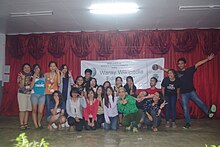 Waray students at a Wikipedia edit-a-thon in the University of the Philippines Visayas Tacloban College (2016) | |
| Total population | |
|---|---|
| 4,106,539 (2020)[1] (3.8% of the Philippine population) | |
| Regions with significant populations | |
(Eastern Visayas, eastern parts of Masbate, Caraga, Sorsogon, and Metro Manila) | |
| Languages | |
| Waray, Cebuano, Tagalog, English | |
| Religion | |
| Predominantly Christian (Catholic) | |
| Related ethnic groups | |
| Other Visayans and Filipino ethnic groups |
The Waray people (or the Waray-Waray people) are a subgroup of the larger ethnolinguistic group Bisaya people, who constitute the 4th largest Filipino ethnolinguistic group in the Philippines.[2] Their primary language is the Waray language (also called Lineyte-Samarnon or Binisaya), an Austronesian language native to the islands of Samar, Leyte and Biliran, which together comprise the Eastern Visayas Region of the Philippines. Waray people inhabit most of Samar where they are called Samareños/Samarnons, the northern part of the island of Leyte where they are called Leyteños, and the island of Biliran. In Leyte island, the Waray-speaking people are separated from the Cebuano-speaking Leyteños by the island's mountain range at the middle.
In the island-province of Biliran, Waray-speaking people live in the eastern part facing Samar island, and Maripipi Island; their Waray dialect is commonly referred to as Biliranon.[3][2] In Ticao island, belonging to Masbate province, Bicol Region, Waray-speaking people dwell in most of the island; who are commonly referred to as Ticaonon.[4] Though Ticaonons identify more with the Masbateño-speaking people of Masbate, being their province-mates.[4] The Bicolano language has more common vocabulary with the Waray language than with other Visayan languages (i.e. Cebuano or Ilonggo).[4]
- ^ "Ethnicity in the Philippines (2020 Census of Population and Housing)". Philippine Statistics Authority. Retrieved July 4, 2023.
- ^ a b Cite error: The named reference
:0was invoked but never defined (see the help page). - ^ "Waray | Ethnic Groups of the Philippines". www.ethnicgroupsphilippines.com. Retrieved May 17, 2023.
- ^ a b c "Language Prayer Profile: Waray". globalrecordings.net. Retrieved May 17, 2023.